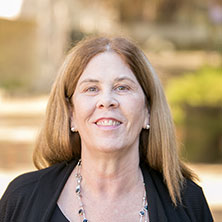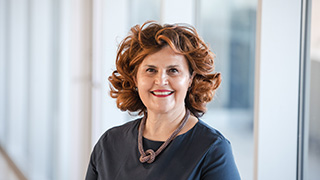Chemistry Leaders Say Boosting Diversity and Green Chemistry are Top Priorities
Friday, October 7, 2022

Cecilia Marzabadi, Ph.D.
Cecilia Marzabadi, Ph.D., professor of Chemistry and Biochemistry at Seton Hall, recalls that when she attended the University of Missouri to earn her Ph.D. in organic chemistry, there were 21 faculty members in the chemistry department — and only one was a woman. "At the time, I didn’t think anything of it. But that one professor would always be putting articles in my mailbox about the glass ceiling for women in chemistry. Other students found her intimidating — she came off rather gruff and tough, which was probably a reflection of her journey in life."
When Marzabadi joined the Seton Hall Department of Chemistry and Biochemistry in 1999, there was only one other woman on the faculty, and sadly, she passed away just a short time later. Marzabadi started seeking out nearby networking events for women in chemistry, where she met a female mentor working in industry. Inspired to branch out, she formed a Seton Hall working group for women faculty members, a group that transcended several fields of science, and enabled women scientists from different schools and departments to support each other’s research and careers.
Marzabadi’s own research interests are centered on carbohydrates, and how they can be used to create new pharmaceuticals. "Carbs lie between both worlds, chemistry and medicine," she says. "They're used in countless ways throughout the body. They coat the surface of every cell in the body, providing structural support to cells and tissues, and act as a food and energy source for the body’s processes. When a virus tries to enter and infect a cell, it uses a carbohydrate as its key. When an egg is fertilized by sperm, a carbohydrate enables that function as well. If you want to get a drug across the blood-brain barrier to treat a neurological disease, you put a sugar on it to help transport it to where it needs to go."
In Marzabadi’s lab at Seton Hall, a group of seven undergrads and one graduate student, researchers are studying ways to use carbohydrates to modulate immune system processes, doing a mix of physical experiments and computer-modeled simulations to explore and discover new combinations and compounds. Every day, Marzabadi gets in the lab to do experiments alongside her students. She’s thrilled to see that students in Seton Hall’s chemistry and biochemistry department are more than 50 percent women.
"I love what I’m doing," she says. "For women and other underrepresented students looking to get into this space, I say hang in there and find people who will be supportive. And don’t take it personally or be discouraged if, at first, this field doesn’t seem too inviting. You might have to look in non-obvious places, but you can find support and mentors that you can relate to."
Recruiting the green chemists of the future
Marzabadi and other faculty members in the Department of Chemistry and Biochemistry are also hoping to better train and recruit the next generation of chemists by providing a curriculum and hands-on experience in green chemistry, a burgeoning area of interest in the field of chemistry that prioritizes sustainability and environmentally friendly chemical processes.
"For students today, green chemistry is of tantamount importance," Marzabadi says. "They've grown up seeing these issues come to life, and the next generation wants to help reverse the negative impact on our planet."
Chemical processes are part of nearly every aspect of modern life, so broadly practicing "greener" chemistry could significantly help reduce pollution and waste. Anything that’s made of wood, metal or natural fibers has been finished with chemical coatings. Chemistry enables the pharmaceuticals that help us maintain health and treat diseases. All plastic products are transformed and fabricated from fossil fuels through chemistry. Without chemical fertilizers to boost crop production, there would not be enough food to support a third of the world’s population.
"Chemistry has always been a large part of what we consider the American Dream — the pursuit of trying to make our lives better," Marzabadi says. "But historically, a lot of that has centered on convenience instead of what’s environmentally friendly."
"Around the time of the Industrial Revolution, chemistry became a really exciting area of discovery in science," says David Laviska, Ph.D., whose work at Seton Hall as an assistant professor led to a position as portfolio manager for green chemistry and sustainability in education at the the American Chemical Society. "Chemists weren’t yet thinking about the potential side effects of waste from chemical reactions. Things started to shift when communities began feeling the ramifications of pollution and toxicity."
Broadly, the chemistry community is very interested in green approaches to designing chemical reactions. After helping to catalyze Seton Hall’s adoption of green chemistry, Laviska is now leading the education-focused efforts of the American Chemical Society’s Green Chemistry Institute.
"We want to overhaul chemical processes so they don’t make a mess in the first place," Marzabadi says. "Doing green chemistry means looking at every aspect of reactions to figure out how to make them cleaner, use solvents that are easier to dispose of and create less by-products, hazardous materials or chemical waste. It’s fundamentally about being aware that when you start doing a chemical process, you think about the process as a whole — what's going into it and what’s coming out of it — in a sustainable, systematic way."
In December 2021, Provost Katia Passerini, Ph.D., launched Seton Hall’s Academy for Green Chemistry, formally galvanizing the efforts of faculty within the Department of Chemistry and Biochemistry, who have completely redesigned laboratory classes and swapped most reactions for greener processes — even those taught in organic chemistry labs.
"Green reactions are safer for students and are also saving the department a lot of money, because a big aspect of green chemistry is about using sustainable processes and smaller amounts of starting materials," says Wyatt "Rory" Murphy, Ph.D., professor of chemistry and biochemistry. "We’re way ahead of the curve — there are only a few departments across the country that are committed to this."
"Students used to be terrified of coming to organic chemistry labs," says Nada Khan, Ph.D., assistant professor of chemistry and biochemistry. "In many experiments we do now, dangerous solvents have been replaced with water." Khan and Laviska worked firsthand on transforming the department’s classes with green chemistry principles and processes.
For students, the switch is also providing a leg up to careers in chemistry, both in industry and academia. "We’ve already seen students go out and get jobs because they know how to do reactions in more sustainable ways," Murphy adds. "Green chemistry is of major interest to many different industrial areas of chemistry, including flavors, fragrances, cosmetics, food chemistry and pharmaceuticals, just to name a few. The field has suddenly awakened to the importance of green chemistry in a big way."
Categories: Science and Technology





